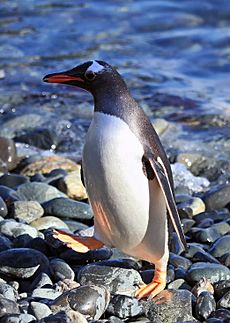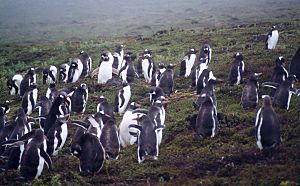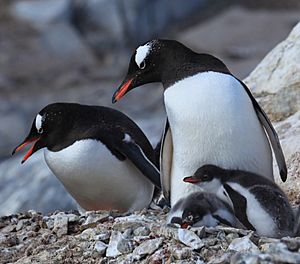Gentoo penguin facts for kids
Quick facts for kids Gentoo penguin |
|
|---|---|
 |
|
| Gentoo penguin | |
| Conservation status | |
| Scientific classification | |
| Kingdom: | |
| Phylum: | |
| Class: | |
| Order: | |
| Family: | |
| Genus: |
Pygoscelis
|
| Binomial name | |
| Pygoscelis papua |
|

The gentoo penguin (Pygoscelis papua) is a type of penguin. You can easily spot them by the white stripe that goes across their head. They are the biggest penguins in the stiff-tailed family. This also makes them the third-largest penguin overall. Only the emperor penguin and the king penguin are bigger.
Contents
What Gentoo Penguins Look Like
Gentoo penguins are easy to recognize. They have a wide white stripe that looks like a bonnet across the top of their head. Their bill is a bright orange-red. They also have pale whitish-pink webbed feet. Their tail is quite long, longer than any other penguin's tail. Baby gentoos have grey backs and white fronts.
When a gentoo penguin walks on land, its tail sticks out behind it. It sweeps from side to side. This is why their scientific name, Pygoscelis, means "rump-tailed." The name papua is a mistake. An early naturalist thought these penguins lived in Papua New Guinea. But no penguins live there!
Gentoos can grow to be about 51 to 90 centimeters (20 to 35 inches) tall. This makes them the third-largest penguin species. Male gentoos can weigh up to 8.5 kilograms (18.7 pounds) before they molt their feathers. Their weight can drop to 4.9 kilograms (10.8 pounds) before mating. Females can weigh up to 8.2 kilograms (18 pounds) before molting. But their weight can go down to 4.5 kilograms (9.9 pounds) when they are guarding their chicks.
Penguins from the northern areas are usually heavier and taller. They are about 700 grams (1.5 pounds) heavier and 10 centimeters (4 inches) taller. Southern gentoo penguins are about 75 to 80 centimeters (29.5 to 31.5 inches) long. They are the fastest swimming penguins underwater. They can reach speeds of 36 kilometers per hour (22 miles per hour)! Gentoos are very good at living in cold, harsh places.
Where the Name "Gentoo" Comes From
It's not clear why these penguins are called "gentoo." The word "gentoo" was once used to describe Hindu people in India. It helped tell them apart from Muslims. The English word might have come from the Portuguese word gentio, meaning "pagan." Some people think the white patch on the penguin's head looks like a turban.
Another idea is that "gentoo" is a changed version of "Johnny penguin." "Johnny" is "Juanito" in Spanish. This sounds a bit like "gentoo." The Johnny rook, a bird that hunts, might have been named after the Johnny penguin.
The specific name papua is a mistake. A naturalist named Johann Reinhold Forster thought these penguins lived in Papua (New Guinea). But the closest gentoos actually live over 6,000 kilometers (3,700 miles) away. No penguins live in New Guinea.
Reproduction and Life Cycle

Gentoo penguins build their breeding colonies on land that is not covered in ice. These colonies can be right on the coast or further inland. They like shallow coastal areas. They often build their nests among clumps of grass. For example, in South Georgia, some colonies are 2 kilometers (1.2 miles) inland. When they nest among grass, they might move their colony a little each year. This is because the grass can get flattened over time.
Gentoos breed on many islands near the Antarctic. The biggest colonies are on the Falkland Islands, South Georgia, and Kerguelen Islands. Smaller groups live on Macquarie Island, Heard Islands, South Shetland Islands, and the Antarctic Peninsula. Scientists think there are over 300,000 breeding pairs in total.
Their nests are usually round piles of stones. They can be quite big, about 20 centimeters (8 inches) high and 25 centimeters (10 inches) wide. The penguins guard their stones very carefully. They can even have loud fights over who owns which stones! Female penguins also really like stones. A male penguin can sometimes get a female's attention by giving her a nice stone.
Females lay two eggs. Each egg weighs about 130 grams (4.6 ounces). Both parents take turns sitting on the eggs. They switch duties every day. The eggs hatch after 34 to 36 days. The chicks stay in the nests for about 30 days. After that, they gather together in groups called creches. The chicks grow their adult-like feathers and go to sea when they are about 80 to 100 days old.
What Gentoo Penguins Eat
Gentoos mainly eat crustaceans, like krill. Fish make up only about 15% of their diet. However, they will eat whatever food is available. Around the Falkland Islands, they eat about equal amounts of fish, squat lobsters, and squid.
How Gentoo Penguins Stay Healthy
Gentoos live in the frozen Antarctic, where there isn't much fresh water. Much of their food is high in salt. To deal with this, they eat animals that have similar salt levels to seawater. But this can still cause problems with too much salt in their bodies, especially for baby gentoos.
To fix this, gentoos and many other sea birds have a special salt gland above their eyes. This gland takes the extra salt from their body. It makes a very salty liquid that drips out of the tip of their beak.
Gentoo penguins don't store as much fat as their close relatives, the Adelie penguins. This is because gentoos don't need as much energy when they hunt for food. They get more energy from hunting than Adelie penguins do. So, adult gentoos don't need big energy stores. However, gentoo embryos (developing babies) need a lot of energy to grow. They use a lot of oxygen as they develop. As the embryo gets bigger, it needs more and more oxygen. This increases quickly until the chick hatches. By then, a chick is using about 1800 mL of oxygen per day.
Threats to Gentoo Penguins

In the water, sea lions, leopard seals, and killer whales hunt gentoo penguins. On land, adult gentoo penguins don't have any natural predators. However, Skuas can steal their eggs. Some other seabirds have also been known to snatch young chicks. Skuas on King George Island have even been seen attacking adult gentoo penguins. They do this during fights over their territories.
Conservation Status
As of 2019, the IUCN Red List says the gentoo penguin is of "least concern." This means their population is stable overall. However, their numbers are quickly dropping in some important areas. This is causing a moderate decline in the species' total population. For example, on Bird Island, South Georgia, the population has fallen by two-thirds in 25 years.
Many dangers still threaten gentoo penguins. These include pollution, hunting, fishing, and human activities like tourism. All of these continue to affect them.
Other Facts
The Linux computer system called Gentoo Linux is named after the gentoo penguin. This is because the gentoo penguin is the fastest swimming penguin. Gentoo Linux aims to be a very fast operating system.
Gallery
-
A Gentoo colony on Carcass Island in the Falklands.
Images for kids
-
A close-up of a Gentoo penguin's head on the West Falkland.
See also
 In Spanish: Pingüino papúa para niños
In Spanish: Pingüino papúa para niños










